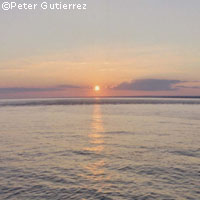Study sheds new light on oceanic carbon sinks
Researchers have shed new light on how iron in the oceans works to boost the uptake of atmospheric carbon dioxide (CO2) by phytoplankton. The work, which brought together researchers from France, the Netherlands, Belgium and Australia, is published in the latest edition of the journal Nature. Like plants on land, phytoplankton absorb CO2 from the atmosphere for photosynthesis. When they die, these microscopic organisms sink to the bottom of the ocean, taking their carbon with them and effectively sequestering it. Often, a lack of the micronutrient iron limits the ability of the phytoplankton to photosynthesise. This has lead some people to suggest seeding the oceans with iron in a bid to increase photosynthesis, thereby reducing atmospheric CO2 and tackling climate change. Laboratory experiments and small scale studies in the ocean itself show that adding iron increases levels of photosynthesis. However, in this latest research the scientists found themselves an enormous natural lab, in the form of a 45,000 square kilometre naturally occurring phytoplankton bloom located just off Kerguelen Island in the Southern Ocean, midway between South Africa and Australia. The bloom is sustained by iron and other vital nutrients entering the system from the deep waters below. The scientists found that the bloom was indeed acting as a CO2 sink, and furthermore the efficiency of fertilisation, defined as the ratio of carbon exported to the ocean depths to the amount of iron supplied, is at least ten times higher than previous estimates from short term iron-addition experiments. However, the researchers warn that their results do not mean that adding large amounts of iron to the oceans will be effective at combating climate change. In the system they studied, iron was added slowly over a long period of time, whereas in experiments where large amounts of iron are added to the ocean in one go, most of the iron is lost. For example, it can stick to sinking particles and be removed from the system that way. The scientists also point out that while the Kerguelen bloom relies on a continuous supply of iron, its long duration is also due to the supply of other nutrients coming into the area from surrounding waters and below. Furthermore, at Kerguelen the iron enters the system from below, which is different from deliberate additions or other natural means of fertilisation such as dust deposition. 'Clearly the natural system is extremely sensitive to iron, far more so than suggested by mesoscale iron addition experiments,' the researchers conclude. 'However, for the reasons presented above, we emphasise that the high sequestration efficiency determined in the Kerguelen bloom should not be taken as an indication that controversial geoengineering CO2 mitigation proposals will be able to obtain high efficiencies.'
Countries
Australia, Belgium, France, Netherlands



